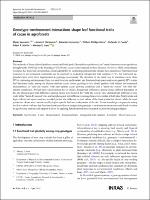| dc.description.abstract | The outbreak of frosty (Moniliophthora roreri) and black pod (Phytophthora palmivora) in Central American cacao agroforests throughout the 1980s led to the breeding of Theobroma cacao clones resistant to these diseases. However, while clonal disease resistance has been well-documented, clonal adaptability to contrasting pedoclimates remains less understood. Plant functional responses to environmental constraints can be assessed by evaluating intraspecific trait variation (ITV), but trait-based approaches have rarely been implemented in genotype assessments. The objective of our study was to determine cacao clone ITV in contrasting environments. Here, we used bivariate, multivariate, and functional trait space analyses to quantify ITV in nine leaf functional traits, among six disease-resistant cacao clones, growing in two clonal gardens with distinct environmental characteristics (a “mild dry season” with near-optimal cacao growing conditions and a “harsh dry season” site with suboptimal conditions). All leaf traits varied among the six clones, though trait differences among clones differed depending on the site: physiological trait differences among clones were larger at the “mild dry season” site, chemical trait differences were wider at the “harsh dry season” site, and morphological trait differences among clones were similar at both sites. Multivariate and
hypervolume trait space analyses revealed greater site influence on trait values of the least productive clones, while the most productive clones were characterized by higher specific leaf area, independent of the site. To our knowledge, our paper is among the first to show evidence that functional traits provide new insights into genotype × environment interactions and clonal selection in agroforestry systems and support in favor of applying functional trait-based research to plant breeding paradigms. | es_ES |


